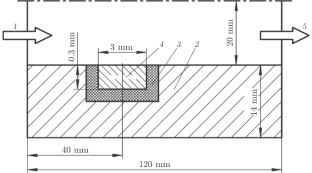超声速流动中实验模型壁面加热的数值模拟
IF 0.5
4区 工程技术
Q4 MECHANICS
Journal of Applied Mechanics and Technical Physics
Pub Date : 2023-06-02
DOI:10.1134/S0021894423020128
引用次数: 0
摘要
本文报道了考虑气流与模拟热电偶敏感元件的铜板之间的共轭传热的通道内超音速湍流的模拟结果。数值模拟进行了自由流马赫数\(\text{M}_{\infty }=3\), 4和5。结果表明,模拟结果与热风洞实验数据吻合较好。结果表明,在100 ms量级的时间内,与钢模型壁的共轭传热可以忽略不计。本文章由计算机程序翻译,如有差异,请以英文原文为准。

NUMERICAL SIMULATION OF HEATING OF EXPERIMENTAL MODEL WALLS IN SUPERSONIC FLOWS
Results of simulations of supersonic turbulent flows in a channel with allowance for conjugate heat transfer between the air flow and a copper plate modeling the sensitive element of a thermocouple are reported. Numerical simulations are performed for free-stream Mach numbers \(\text{M}_{\infty }=3\), 4, and 5. It is shown that the simulation results agree well with experimental data obtained in a hotshot wind tunnel. It is found that the conjugate heat transfer with the model walls made of steel can be ignored at times of the order of 100 ms.
求助全文
通过发布文献求助,成功后即可免费获取论文全文。
去求助
来源期刊
CiteScore
1.20
自引率
16.70%
发文量
43
审稿时长
4-8 weeks
期刊介绍:
Journal of Applied Mechanics and Technical Physics is a journal published in collaboration with the Siberian Branch of the Russian Academy of Sciences. The Journal presents papers on fluid mechanics and applied physics. Each issue contains valuable contributions on hypersonic flows; boundary layer theory; turbulence and hydrodynamic stability; free boundary flows; plasma physics; shock waves; explosives and detonation processes; combustion theory; multiphase flows; heat and mass transfer; composite materials and thermal properties of new materials, plasticity, creep, and failure.

 求助内容:
求助内容: 应助结果提醒方式:
应助结果提醒方式:


